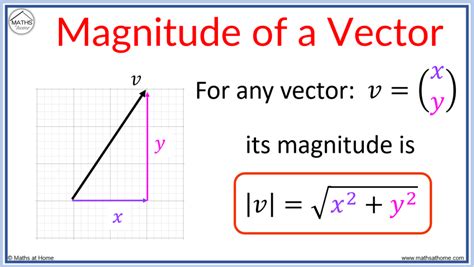How to Calculate the Magnitude of a Vector: A Comprehensive Guide
Understanding how to calculate the magnitude of a vector is fundamental in various fields, including physics, engineering, and computer graphics. This guide provides a clear and concise explanation, equipping you with the knowledge to tackle vector magnitude calculations with confidence.
What is a Vector?
Before diving into magnitude calculations, let's briefly review what a vector is. A vector is a mathematical object that has both magnitude (size or length) and direction. It's often represented visually as an arrow, where the arrow's length represents the magnitude and the arrow's direction indicates the vector's orientation. Vectors are commonly represented in two or three dimensions, using coordinates. For example, a 2D vector might be represented as v = (3, 4), and a 3D vector as v = (1, 2, 3).
Calculating the Magnitude of a Vector
The magnitude of a vector is calculated using the Pythagorean theorem, extended to higher dimensions.
2D Vectors
For a 2D vector v = (x, y), the magnitude (often denoted as ||v|| or |v|) is calculated as:
||v|| = √(x² + y²)
Example:
Let's say we have a vector v = (3, 4). Its magnitude would be:
||v|| = √(3² + 4²) = √(9 + 16) = √25 = 5
3D Vectors
For a 3D vector v = (x, y, z), the magnitude calculation extends naturally:
||v|| = √(x² + y² + z²)
Example:
If we have a 3D vector v = (1, 2, 2), its magnitude is:
||v|| = √(1² + 2² + 2²) = √(1 + 4 + 4) = √9 = 3
N-Dimensional Vectors
The concept extends to vectors with any number of dimensions (n). For an n-dimensional vector v = (x₁, x₂, ..., xₙ), the magnitude is:
||v|| = √(x₁² + x₂² + ... + xₙ²)
Why is Calculating Vector Magnitude Important?
Understanding vector magnitude is crucial for numerous applications:
- Physics: Calculating speed, velocity, and force. The magnitude of a velocity vector represents speed.
- Engineering: Determining the size and direction of forces acting on structures.
- Computer Graphics: Used extensively in 3D modeling, animation, and game development for distance calculations and object manipulation.
- Machine Learning: Vector magnitude plays a critical role in various algorithms, particularly in measuring distances between data points.
Tips and Tricks for Success
- Double-check your calculations: Ensure you're squaring each component correctly before summing and taking the square root.
- Use a calculator: For complex calculations, using a calculator (or programming language) is recommended for accuracy.
- Understand the context: The meaning of the magnitude depends on the application. In physics, it might represent speed; in computer graphics, it might represent distance.
By mastering the calculation of vector magnitude, you'll gain a fundamental understanding of vector mathematics and its broad applications across diverse fields. Remember to practice regularly to solidify your understanding and build confidence in your problem-solving abilities.
